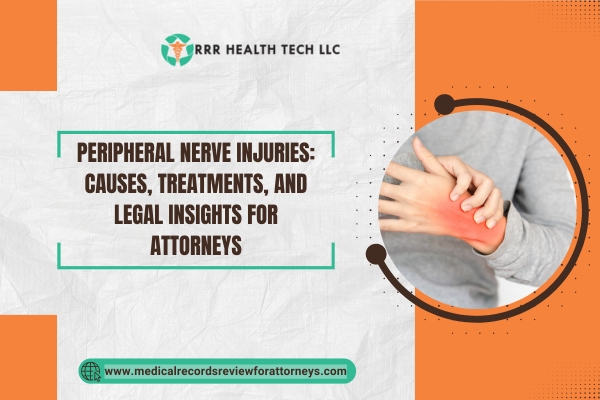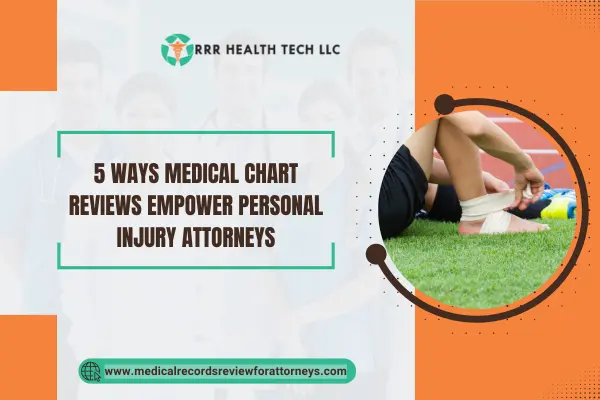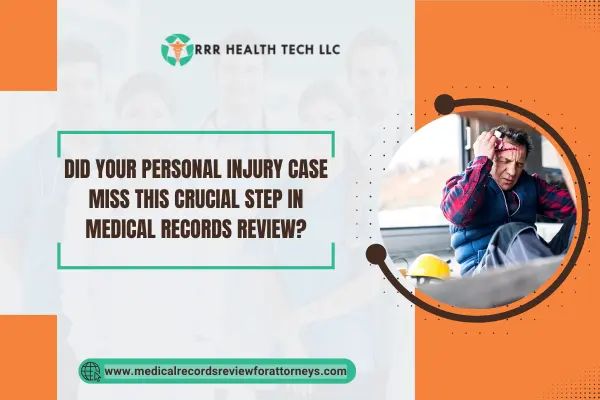
Introduction
Chronic pain, loss of function, and emotional suffering are often consequences of wean peripheral nerve injuries. The complexity of these issues for patients requires the medical, legal, and social-economic fields to be well coordinated. Unlike typical cases, these claims require special attention for different healthcare providers and medical record review services can assist attorneys in their legal cases. In this article, the most important aspects peripheral nerve injuries are presented, along with the medical implications for clinicians involved in the legal processes.
What Are Peripheral Nerve Injuries?
Definition and Overview
Peripheral Nerve Injury: Damage to the peripheral nerves, which transmit signals between the central nervous system and the rest of the body.
Types of Injuries:
Trauma is sustained through sharp physical actions that damage soft and hard tissues. This is classified further into neuropraxia, axonotmesis, neoctometis, these injuries vary in severity and characteristics.
Acute and chronic motivos sustained through actions such as typing that aid in incurring the carpal syndrome.
Medical aides include uncontrolled diabetes, open infections, autoimmune diseases.
Common Causes
• Trauma: Some injuries may result from a car accident, falls, or sports.
• Repetitive Motion: Certain conditions such as carpel tunnel syndrome and others may result from performing the same action repeatedly.
• Medical Conditions: The most common ones are diabetes, infections, and autoimmune diseases.
Symptoms of Peripheral Nerve Injuries
Common Symptoms
• “Tingling” of the Affected Region: This indicates the nerve has sustained some injury.
• Weakness: It is hard to move the affected limb or muscle.
• Pain: The affected region of the limb may have sharp, burning, or aching sensations.
• Stimulation: The ability to experience sensory stimuli is heightened.
Diagnosis
• Physical Examination: Evaluation of the symptoms presented and level of physical activity.
• Electromyography (EMG): This test records activity in individual muscles.
• Nerve Conduction Studies: Evaluation of the speed that electric signals travel through nerves.
Treatment Options for Peripheral Nerve Injuries
Conservative Treatments
• Physical Therapy: Aims at restoring function and strength to the limb.
• Medications: Pain killers, anti-inflammatory medication, and medication for nerve pain.
• Life Style Alteration: Devices that alter the normal way movement is done along with restriction of certain actions that result in periodic strain.
Surgical Treatments
• Nerve Repair: surgical methods used to reconnect nerves that are not positioned close enough to each other.
• Nerve Grafting: Involve a severed nerve joining where another nerve is cut.
• Decompression Surgery: Surgical intervention where constriction over the nerve is removed.
Legal Implications for Attorneys
Understanding Medical Malpractice
• Statement: Medical injuries happen when a healthcare specialist does not provide required help needed to receive an injury.
• Proving Negligence: Lawyers need to prove that the action of the healthcare provider is what brought about the nerve injury.
The Role of Medical Records Review Services
Importance of Medical Records: Comprehensive reviews can uncover evidence of negligence, such as:
Incomplete documentation of treatment.
Lack of follow-up care.
How We Assist Attorneys: Our medical records review services provide detailed analyses that help attorneys build stronger cases.
Case Studies
Case Study 1: Workplace Injury Leading to Nerve Damage
• Overview: An employee at a factory sustained a crush injury to the arm which leads to nerve damage.
• Challenges: Determining the degree of the injury and how it affects the patient’s capacity to work.
• Solutions: Thorough medical record review demonstrated the extent of injury and required continuing treatment.
Case Study 2: Nerve Injury Due to Surgical Malpractice
• Overview: patient sustained nerve damage after a surgical procedure secondary to use of improper surgical technique.
• Challenges: Establishing the surgical mistake as the proximate cause of nerve injury was not easy.
• Solutions: Deviations from accepted surgical standards were evaluated in the case documents.
Conclusion
The attorneys on these cases should better understand peripheral nerve injuries. With this knowledge, attorneys can devise better strategies to protect their clients’ rights from possible violations. The use of medical record review services improves the chances of creating robust cases so that the patients may receive the appropriate amount of compensation for their injuries.


